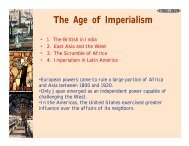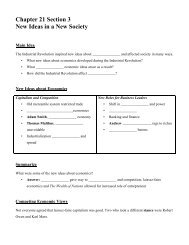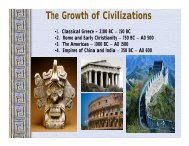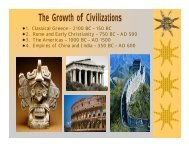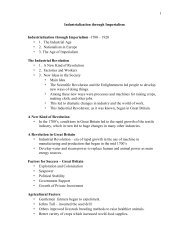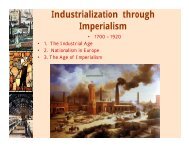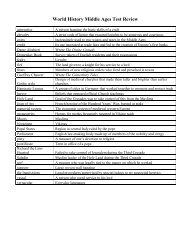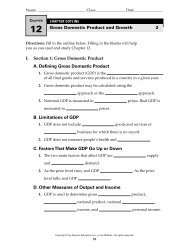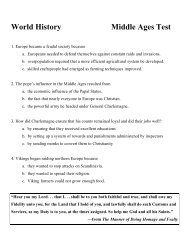The Second Industrial Revolution Power Point Notes
The Second Industrial Revolution Power Point Notes
The Second Industrial Revolution Power Point Notes
You also want an ePaper? Increase the reach of your titles
YUMPU automatically turns print PDFs into web optimized ePapers that Google loves.
<strong>Industrial</strong> America A Nation<br />
Transformed<br />
1860 - 1910<br />
1. <strong>The</strong> Western Crossroads 1860 - 1910<br />
2. <strong>The</strong> <strong>Second</strong> <strong>Industrial</strong> <strong>Revolution</strong> – 1865 - 1905<br />
3. <strong>The</strong> Transformation of American Society – 1865 - 1910<br />
•Hey Mikey Boylan!<br />
•What Kyle Williams?<br />
• “Look at this class.<br />
Boy, do they got it<br />
Easy!”<br />
Yeah, “Kyle I wish I<br />
could read!”<br />
This looks like Josh Codis
<strong>The</strong> <strong>Second</strong> <strong>Industrial</strong> <strong>Revolution</strong><br />
1865 - 1905<br />
1. <strong>The</strong> Age of Innovation<br />
2. <strong>The</strong> Rise of Big Business<br />
3. Labor Strives To Organize<br />
• During the first half of the 1800’s, the United States population<br />
expanded rapidly westward.<br />
• Cause of this growth was fueled by immigration, industrialization,<br />
and the economic opportunities of the frontier.<br />
• Significance - industrialization led to poor working conditions that<br />
led workers to organize unions and improve daily lives
Thomas Edison<br />
•Can you believe I failed<br />
one thousand times<br />
before I invented the<br />
light bulb?!<br />
•<strong>The</strong> Wizard of Menlo<br />
Park
1. <strong>The</strong> Age of Innovation<br />
1860 - 1910<br />
– Following the years of the Civil War, the<br />
United States experienced a wave of<br />
scientific discoveries and inventions. She<br />
also experienced a surge of industrial<br />
growth.<br />
– <strong>The</strong> First <strong>Industrial</strong> <strong>Revolution</strong><br />
• Coal and steam made possible the first industrial<br />
revolution in the United States.<br />
• Coal-fed steam engines powered factories and<br />
these factories in turn produced goods that<br />
generated economic growth.
1860 - 1910<br />
<strong>Industrial</strong> Innovation<br />
• In the late 1800’s, an abundance of steel helped spur the second<br />
period of industrialization.<br />
• <strong>The</strong> Bessemer Process -created in 1850, Henry Bessemer in Great<br />
Britain, a method of steel making that burned off the impurities in<br />
molten iron with a blast of hot air.<br />
Allowed for<br />
practical use of<br />
steel and more<br />
affordable<br />
Because of this<br />
process 1865-<br />
15,000 tons of<br />
steel to 1919 – 28<br />
million tons of<br />
steel
1860 - 1910<br />
Refined Oil<br />
• <strong>The</strong> development of a process to refine oil also affected the<br />
industrial period.<br />
Edwin Drake<br />
– This process to refine oil could then be used for fuel to<br />
turn into kerosene, which could be burned in lamps to<br />
produce light or used as fuel.<br />
– In 1859, Edwin Drake used a steam engine to drill for oil<br />
near Titusville, Pennsylvania.<br />
– “Drake’s Folly,” as it was called, turned out to be quite<br />
significant. By the 1880’s, oil wells were located all over<br />
Pennsylvania and West Virginia and production topped 25<br />
million barrels of oil.<br />
– Innovations in steel and oil industries also affected<br />
the transportation industry.
Picture of an oil well<br />
1860 - 1910
Edwin Drake, wearing a top hat, visits his oil<br />
well near Titusville Pa
<strong>The</strong> Age of Transportation<br />
1860 - 1910<br />
• New technologies and the “age of inventions”<br />
resulted in a massive expansion of railroads<br />
and laid the groundwork for the automobile<br />
and airplanes.<br />
• <strong>The</strong> developments in transportation were<br />
crucial to bring Americans closer to one<br />
another as well as to the development of the<br />
West.<br />
•Not yet!
1860 - 1910<br />
<strong>The</strong> Railroads<br />
• <strong>The</strong> availability of cheap steal, due to the Bessemer process, had a<br />
significant impact on the railroad industry.<br />
• In 1869, the transcontinental railroad was completed when the Union<br />
Pacific and the Central Pacific joined to make a single rail line from<br />
Nebraska to the Pacific Ocean.<br />
• George Westinghouse developed an air-compressed brake, which made<br />
the locomotives safer.<br />
George Westinghouse
<strong>The</strong> horseless carriage<br />
1860 - 1910<br />
• About 1770, the forerunner of the automobile was the horseless<br />
carriage. Not very successful due to the cost.<br />
• By 1876, Nikolaus A. Otto invented the first internal combustion<br />
engine powered by gasoline. Within twenty years, Charles and J.<br />
Frank Duryea built the first practical motorcar in the United<br />
States.<br />
• <strong>The</strong> wealthy class was the only class at the time that could afford<br />
the horseless carriage.<br />
Charles and J. Frank Duryea<br />
Nikolaus A. Otto
THEN<br />
NOW
Airplanes<br />
1860 - 1910<br />
• <strong>The</strong> internal combustion also led to advances in<br />
flight.<br />
• Orville and Wilbur Wright of Dayton, Ohio,<br />
developed one of the first working airplanes.
I can see my house from here!
Communication<br />
1860 - 1910<br />
• <strong>The</strong> advancements in communication also<br />
furthered the growth of American industry.<br />
Americans did not have cell phones back<br />
then; how did they live!!!
<strong>The</strong> Telegraph<br />
1860 - 1910<br />
• Samuel F.B. Morse developed the<br />
telegraph, which was a means of<br />
communicating using wires with<br />
electricity.<br />
• By 1866, Western Union, the<br />
leading telegraph company, had<br />
more than 2,000 telegraph<br />
offices.<br />
Samuel F.B. Morse<br />
.--/. . . ./.-/- // . . . ./.-/-/. . . . // --./---/-..<br />
.--/.-./---/..-/--./. . . ./-/ .-.-.-<br />
What hath God wrought?
1860 - 1910<br />
<strong>The</strong> Telephone<br />
• Alexander Graham Bell, in 1876,<br />
introduced the talking telegraph<br />
or telephone.<br />
• By the end of the 1800’s, more<br />
than one million telephones had<br />
been installed and Bell<br />
Telephone Company eventually<br />
became American Telephone and<br />
Telegraph AT&T, one of the<br />
largest and longest lasting<br />
monopolies.
1860 - 1910<br />
Typewriter<br />
• Christopher Sholes invented the typewriter in<br />
1867.<br />
• <strong>The</strong> invention of the typewriter also had an<br />
impact on industries.
1860 - 1910<br />
Thomas Edison and Menlo Park<br />
– Thomas Edison and his fellow<br />
researchers mad significant<br />
discoveries in the telegraph,<br />
electricity, light bulbs, phonographs,<br />
and early motion-picture cameras.<br />
– He opened a workshop in Menlo Park,<br />
New Jersey where he assembled a<br />
team of researchers and by 1931,<br />
Edison and his team had over 1,000<br />
patents.
2. <strong>The</strong> Rise of Big Business<br />
1860 - 1910<br />
• “Eureka! We have found it. Here<br />
was something new to all of us, for<br />
none of us had ever received<br />
anything but from toil.”<br />
• Andrew Carnegie, <strong>The</strong> Andrew<br />
Carnegie Reader<br />
• As a young man, he invested in<br />
Adams Express and soon began<br />
investing in railroad and iron<br />
industries.<br />
• Made him a very wealthy man!<br />
Andrew Carnegie
1860 - 1910<br />
Capitalism<br />
Adam Smith<br />
• Capitalism-an economic system in which<br />
private business ran most industries, and<br />
competition determines how much goods cost<br />
and workers are paid.<br />
• Over the course of the late 1800’s,<br />
businessmen set out to gain economic wealth<br />
by building industries by taking advantage of<br />
the era’s new technological advances.<br />
• During the <strong>Second</strong> <strong>Industrial</strong> <strong>Revolution</strong>,<br />
Horatio Alger published several novels that<br />
reflected the American ideal of self-reliant<br />
individualism (HARD WORK!!!)<br />
• Free enterprise is an economic system in<br />
which businesses were let free from<br />
government regulation.
1860 - 1910<br />
Communism<br />
• Karl Marx, a German philosopher believed in a<br />
political system that proposed that individual<br />
ownership of property should not be allowed.<br />
• Property and means of production are owned<br />
by everyone (government) in the community.<br />
Karl Marx
1860 - 1910<br />
Social Darwinism<br />
Herbert Spencer<br />
– Charles Darwin’s biological theory of<br />
natural selection and evolution and<br />
the newly political theory of social<br />
Darwinism.<br />
• Charles Darwin’s theory- followed the natural<br />
law of “survival of the fittest” (the top of the<br />
food chain – humans)<br />
• Social Darwinism – Herbert Spencer follows<br />
this biological theory and applies it to politics.<br />
<strong>The</strong> “fittest” people, businesses, or nations<br />
would rise to positions of wealth and the<br />
“unfit” would fail.
1860 - 1910<br />
<strong>The</strong> Birth of the Corporation<br />
– In the late 1800’s, the<br />
face of American<br />
business changed<br />
dramatically.<br />
– Business leaders turned<br />
to corporations.<br />
• Corporations are organizations in<br />
which members raise money by<br />
selling shares of stock in the<br />
company.<br />
• Stockholders- those who buy<br />
shares – receive a percentage of<br />
the corporation’s profits, known as<br />
dividends.
1860 - 1910<br />
<strong>The</strong> Stock Market<br />
• Public ownership of<br />
corporations and trading<br />
of stock introduced<br />
another source of income<br />
in the stock market.<br />
• Stock brokers such as<br />
Jay Gould earned millions<br />
trading stock. (Gould 77<br />
million in trading railroad<br />
stock)<br />
Jay Gould
1860 - 1910<br />
Trusts<br />
– Some companies, or corporations,<br />
formed trusts.<br />
• Trusts are when companies turn control of<br />
their stock to a common board of trustees.<br />
• If a trust gains an exclusive control of an<br />
industry, a company holds a monopoly, or<br />
complete control over the price and quality of<br />
a product.
1860 - 1910<br />
Andrew Carnegie<br />
• Steel leader Andrew<br />
Carnegie, born in Scotland,<br />
immigrated to the United<br />
States in 1848 at the age of<br />
12.<br />
• In his twenties, he began to<br />
invest in stock in numerous<br />
ventures in transportation<br />
and communications. <strong>The</strong>se<br />
early ventures provided the<br />
funding for him to invest in<br />
the steel industry.
1860 - 1910<br />
U.S. Steel Industry<br />
• Carnegie entered the iron and steel business in<br />
the early 1860’s.
1860 - 1910<br />
Vertical Integration<br />
• Vertical integration – the principal of acquiring<br />
companies that provided the materials and<br />
services upon which his enterprises depended<br />
• In 1899, Carnegie organized all of his<br />
companies into the Carnegie Steel Company.<br />
• In 1901, Carnegie sold his company to banker<br />
J.P. Morgan for nearly $500 million. Carnegie<br />
retired as the world’s richest man.
1860 - 1910<br />
<strong>The</strong> Gospel of Wealth<br />
• Carnegie was rich! <strong>The</strong>re is no doubt. However, he was quite virtuous.<br />
• Through his philosophy of the “Gospel of Wealth,” Carnegie insisted<br />
that the rich had a moral obligation to manage their wealth in a way<br />
that benefited all members of society.<br />
• He donated more than 350 million to charity.
John D. Rockefeller and<br />
1860 - 1910<br />
Standard Oil<br />
• In 1863, after being quite<br />
profitable in the wholesale<br />
food business, tycoon John D.<br />
Rockefeller entered the<br />
growing oil industry and<br />
eventually founded Standard<br />
Oil.<br />
• <strong>The</strong> oil refining industry during<br />
its early years was composed of<br />
several small, competitive<br />
companies<br />
• John D. Rockefeller set out to<br />
gain control of the industry.
1860 - 1910<br />
Horizontal Integration<br />
• He too used vertical integration and acquired<br />
all companies that were necessary for the oil<br />
companies.<br />
• He also practiced horizontal integration which<br />
was one company’s control of other companies<br />
producing the same product.<br />
– By 1880, Standard Oil Company<br />
controlled 90% of the oil industry;<br />
however, like Carnegie, he donated<br />
more than $80 million to the<br />
University of Chicago and<br />
approximately $550 million to<br />
philanthropic causes.
1860 - 1910<br />
<strong>The</strong> Railroad Giants<br />
• Other entrepreneurs, such as Cornelius<br />
Vanderbilt, George Westinghouse, and George<br />
Pullman, built large fortunes by capitalizing on<br />
the booming railroad industry.<br />
Cornelius Vanderbilt<br />
George Westinghouse<br />
George Pullman
1860 - 1910<br />
Cornelius Vanderbilt<br />
• A pioneer of the railroad industry<br />
• Gained control of the New York Central<br />
Railroad and extended his railroad system by<br />
purchasing many other smaller lines.<br />
• By his death in 1877, he controlled more tan<br />
4,500 miles of track and his personal fortune<br />
was set a net worth of $100 million.
1860 - 1910<br />
George Westinghouse<br />
• In 1823, George Westinghouse established the<br />
Westinghouse Air Brake Company.<br />
• His air brake was an important safety feature<br />
for the railroad industry and after a period of<br />
five years, more than 7,000 passenger cars<br />
were equipped with the compressed-air brake.
1860 - 1910<br />
George Pullman<br />
• <strong>The</strong> Luxury of long distance rail<br />
• One very successful railroad giant was George<br />
Pullman, who sought to make long-distance rail<br />
travel more comfortable.<br />
• His factory built sleeping cars, dining cars, and<br />
luxurious cars for wealthy passengers.
1860 - 1910<br />
Mass Marketing<br />
• New methods in marketing to sell company<br />
products were created.<br />
• This eventually led to the department store.
1860 - 1910<br />
Market Products<br />
• With the dramatic increase of manufacturing in<br />
the United States, companies developed new<br />
ways of persuading people to consume their<br />
product.<br />
– “Standard Oil” set the standard for the oil<br />
industry.<br />
– Phoebe Snow on the Delaware and Lackawanna<br />
Railroad.<br />
• Advertisement through magazines, newspapers<br />
and billboards encouraged consumers to buy<br />
their products.
<strong>The</strong> first department stores<br />
• In cities new types of stores, such as Macys, Wanamakers, Marshall<br />
Fields, and the most famous chain store, Woolworths, became the<br />
first department stores.<br />
• <strong>The</strong>se stores targeted women.<br />
1860 - 1910
3. <strong>The</strong> Organization of Labor<br />
1860 - 1910<br />
• “It is true, that wealth has been<br />
greatly increased . . . but these gains<br />
are not general. In them the lowest<br />
class do not share . . . This association<br />
of poverty with progress is the great<br />
enigma [mystery].”<br />
– Henry George, Progress and Poverty<br />
Henry George, American Economist
1860 - 1910<br />
Government and Big Business<br />
• Most often, the government policies concerning business<br />
practices favored the industrialists, and not the workers.<br />
• Most opposed government interference in business activities<br />
(laissez faire)
<strong>The</strong> Sherman Anti-Trust<br />
1860 - 1910<br />
• In 1890, in response to the<br />
growing uproar from the public,<br />
the government passed the<br />
Sherman Anti-Trust act<br />
• This act outlawed all monopolies<br />
and trusts that restrained<br />
trade. <strong>The</strong> proved very<br />
difficult to enforce and<br />
monopolies continued to grow.<br />
– By 1890, 10% of the<br />
population controlled<br />
close to 75% of the<br />
nation’s wealth.
1860 - 1910<br />
<strong>The</strong> New Working Class<br />
– By 1900, one third of the nation’s industrial<br />
working class was foreign.<br />
– Some northern and Midwestern industries<br />
offered work to the thousands of African<br />
Americans looking for work, while the South<br />
barred African Americans from holding factory<br />
jobs.<br />
– <strong>The</strong> number of women workers doubled between<br />
1870 and 1890, and by 1900, women accounted<br />
for 18% of the work force.<br />
– <strong>The</strong> number of children in the work force<br />
increased dramatically as well.<br />
• Working Conditions were horrible for all workers,<br />
especially women and children. Most worked ten<br />
hour days for less than $10 a week.
<strong>The</strong> Knights of Labor<br />
1860 - 1910<br />
– Workers called for change as conditions worsened.<br />
– <strong>The</strong> National Labor Union was the first nationwide federation<br />
of craft and industrial workers organized in 1866, and fell<br />
apart in the 1870’s.<br />
– In 1869, Uriah Stephens founded the Knights of Labor, an early<br />
successful labor union.<br />
• In 1879, under Terence Powderly, an Irish Catholic political machinist,<br />
membership increased dramatically, including attracting other workers like<br />
women, and eventually African Americans.<br />
– Powderly led the Knights of Labor for 14 years, and under his<br />
leadership, the union fought for temperance, the eight-hour<br />
workday, equal pay for equal work, and an end to child labor.<br />
Uriah Stephens<br />
Terence Powderly
1860 - 1910<br />
<strong>The</strong> Great Upheaval<br />
– In 1877, a great railroad strike<br />
occurred which affected the labor<br />
movement.<br />
– In July, railroad workers in<br />
Martinsburg, Virginia went on strike<br />
in reaction to a pay cut.<br />
• President Rutherford B. Hayes sent the<br />
military to defend the railroad; this only<br />
infuriated the workers more and the strike<br />
soon spread to fourteen states.<br />
• Throughout 1886, the nation experienced a<br />
year of intense strikes and violent labor<br />
confrontations that became know as the Great<br />
Upheaval.
1860 - 1910<br />
<strong>The</strong> Haymarket Riot<br />
• On May 1, 1886, some 40,000 Chicago<br />
workers joined a strike against the<br />
McCormick Harvesting Machine<br />
Company.<br />
• On May 3, 1886, a confrontation<br />
between police and strikers left 2<br />
strikers dead.<br />
• In protest, the workers met at<br />
Chicago’s Haymarket Square and when<br />
200 police officers arrived chaos<br />
started. A bomb exploded! When the<br />
smoke cleared, some 60 officers were<br />
wounded. Seven officers and one<br />
civilian were dead.<br />
• <strong>The</strong> police arrested and charged eight<br />
men. Four were hanged.
1860 - 1910<br />
Workers Activism<br />
• Alarmed by the violence of the Great<br />
upheaval, many skilled workers broke with the<br />
unskilled laborers and joined the American<br />
Federation of Labor (AFL).<br />
• <strong>The</strong> AFL, formed by Samuel Gompers in 1886,<br />
organized independent craft unions into a<br />
group that worked to advance the interests of<br />
skilled workers.
1860 - 1910<br />
<strong>The</strong> Homestead Strikes<br />
• In 1892, <strong>Industrial</strong> workers at Carnegie Steel<br />
Company in Homestead, Pennsylvania went on<br />
strike to protest wage cuts. A violent clash<br />
eventually resulted in 16 deaths.
<strong>The</strong> Pullman Strikes<br />
1860 - 1910<br />
– In May 1894, workers<br />
at the Pullman<br />
sleeping-car factory<br />
in Pullman, Illinois,<br />
went of strike due to<br />
lower wages.<br />
• Eugene V. Debs, President of<br />
the American Railway Union,<br />
(ARU) encouraged the strike.<br />
• <strong>The</strong> government, under the<br />
Cleveland administration,<br />
ordered an end to the ARU<br />
strike, claiming the strikers<br />
were committing a federal<br />
offense by preventing the<br />
delivery of U.S. mail.<br />
• In the end, the Pullman strike<br />
had been broken and the ARU<br />
destroyed.
Where does President Barack<br />
Obama belong?



